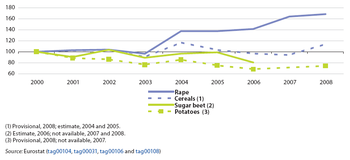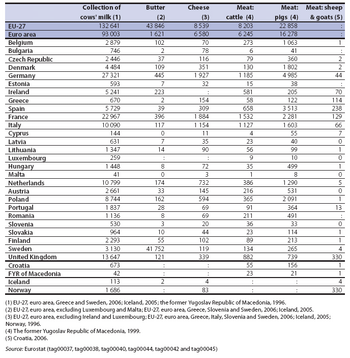Archive:Agricultural products
- Data from October 2009, most recent data: Further Eurostat information, Main tables and Database.
[[Image:Utilization of milk, EU, 2008.png |thumb|right|350px|Graph 4: Utilization of milk, EU, 2008 (1) (%)]]
Collecting data on agricultural products is important for understanding developments in markets across the European Union (EU): both current data (estimated production levels for the current year) and historical data (to help distinguish between cycles and changing production patterns for example). They make it possible to analyze the response of markets to policy actions and to test policy scenarios. Agricultural product data, because they provide information on the supply side, are important for understanding corresponding price developments (which are of particular interest to agricultural commodity traders and policy analysts), but they can also illustrate the consequences of policy decisions taken on agriculture.
More detailed analyses of crop production and livestock at regional level are also available.
Main statistical findings
Crops
A summary of EU agricultural crop production in 2007 is given in Table 1. In 2008 the EU produced 311.5 million tonnes of cereals, of which a little under half (47.8 %) was wheat, around one-fifth (20.8 %) barley, and another fifth grain maize (20.1 %). Graph 2 shows comparable figures for 2007. France and Germany were by far the largest cereal, sugar beet and rape producers, together accounting for around 38 % of EU cereal production and approximately 52 % of sugar beet and rape production in 2008. Cereal production in the EU fluctuated between 2000 and 2008 (see Graph 1), with a 19% increase between 2007 and 2008. Potatoes and sugar beet production decreased through to 2008, while rape production increased considerably during this period.
In the EU, the most important vegetables in terms of production were tomatoes, onions and carrots, while the most important fruits were apples, oranges and peaches (see Graphs 3 and 4 respectively). Spain and Italy had the largest vegetable and fruit production. Spain produced more than 12.3 million tonnes of vegetables, while Italy produced approximately 13.3 million tonnes. Both Member States produced around 20 million tonnes of fruit. Indeed, together these two Member States produced more fruit than all the other Member States together.
Meat and milk
Table 2 summarizes agricultural production related to animals across the EU. The principal meat product in the EU is pig meat (22.9 million tonnes in 2007), significantly more than other types of meat, such as beef/veal (8.2 million tonnes). A little over one-fifth (21.8 %) of EU pig meat production came from Germany, the next highest contributions coming from Spain (15.4 %) and France (10.0 %): the 7.9 % share for Denmark is also notable. A little under one-fifth (18.7 %) of beef/veal in the EU was produced in France in 2007, with further significant production coming from Germany, Italy, the United Kingdom, Spain and Ireland.
Dairy production has a diverse structure among Member States, both as a result of varying farm and dairy herd sizes as well as yields. However, since 1984, milk production has been controlled through a system of milk quotas that effectively puts a limit on the amount produced. Germany and France have by far the largest quotas, and the 27.3 million tonnes of milk collected in Germany in 2007 was double the third highest level collected in the United Kingdom. Graph 5 shows that one-third (32.6 %) of the milk collected in the EU in 2007 was converted into cheese, with butter accounting for the next highest proportion (24.4 %). In 2007, only one-tenth (10.1 %) of the milk collected was used as drinking milk.
Data sources and availability
Annual statistics on the production of 200 specific crops are mostly covered by Council regulations, although the data for fresh fruit and vegetables are collected under various informal agreements with Member States.
Crop production figures relate to harvested production. Agricultural production of crops is harvested production (excluding losses to the harvest). The harvested production includes marketed quantities, as well as quantities consumed directly on the farm, losses and waste on the holding, and losses during transport, storage and packaging.
Statistics on milk, eggs and meat products are also compiled according to Community legislation. Milk production covers farm production of milk from cows, sheep, goats and buffaloes. A distinction is made between milk collected by dairies and milk production on the farm. Milk collection is only a part of the total use of milk production on the farm, the remainder generally includes domestic consumption, direct sale and cattle feed. Dairy cows are female bovines that have calved (including any aged less than two years). They are cows kept exclusively or principally for the production of milk for human consumption and/or dairy produce, including cows for slaughter (fattened or not) between last lactation and slaughter.
Meat production is based on the carcass weight of meat fit for human consumption. The concept of carcass weight varies according to the animal under consideration. For pigs (the species Sus), it is the weight of the slaughtered pig’s cold body, either whole or divided in half along the mid-line, after being bled and eviscerated and after removal of the tongue, bristles, hooves, genitalia, flare fat, kidneys and diaphragm. Regarding cattle (the species Bos taurus), it is the weight of the slaughtered animal’s cold body after being skinned, bled and eviscerated, and after removal of the external genitalia, the limbs, the head, the tail, the kidneys and kidney fats, and the udder. For sheep and goats, the carcass weight is the slaughtered animal’s cold body after having been bled, skinned and eviscerated, and after removal of the head, feet, tail and genital organs; kidneys and kidney fats are included. For poultry (defined as hens, chicken, ducks, turkey, guinea fowl and geese), the weight is the cold body of slaughtered farmyard poultry after being bled, plucked and eviscerated; the value includes poultry offal, with the exception of foie gras. For all other animal species, the carcass weight is considered to be the weight of the animal’s cold body.
Context
In October 2007 the Council adopted legislation to establish a single Common market organization for agricultural products. This is designed to reduce the volume of legislation in the farming sector, improve legislative transparency, and make agricultural policy more easily accessible. During the course of 2008, the single CMO has replaced 21 CMOs for a variety of different products such as bananas, eggs, sugar or wine.
Further Eurostat information
Publications
- Agricultural statistics – Main results - 2006-2007 pocketbook
- Agriculture – Main statistics - 2005-2006 pocketbook
- Agriculture – Main statistics - 2007-2008 pocketbook
Main tables
- Agriculture, see:
- Agricultural products (t_apro)
- Crops products (t_apro_cp)
- Poultry farming (t_apro_ec)
- Milk and milk products (t_apro_mk)
- Animal production (t_apro_mt)
Database
- Agriculture, see:
- Agricultural products (apro)
- Crops products (apro_cp)
- Poultry farming (apro_ec)
- Milk and milk products (apro_mk)
- Animal production (apro_mt)
Dedicated section
Other information
- Council Regulation (EEC) No 837/90 on the statistical information to be supplied by the Member States on cereals production and Council Regulation (EEC) No 959/93 on statistical information on crop products other than cereals.
- Milk statistics are governed by Council Directive 96/16/EC and Directive 2003/107/EC of the European Parliament and of the Council.
- For porcine, bovine, ovine and caprine species, the rules for producing statistics are stipulated in Directives 93/23/EEC, 93/24/EEC and 93/25/EEC and in Commission decisions 2004/760/EC, 2004/761/EC and 2004/747/EC.
External links
- European Commission - Agricultural Product Quality
- European Commission - Single Common Market Organization




